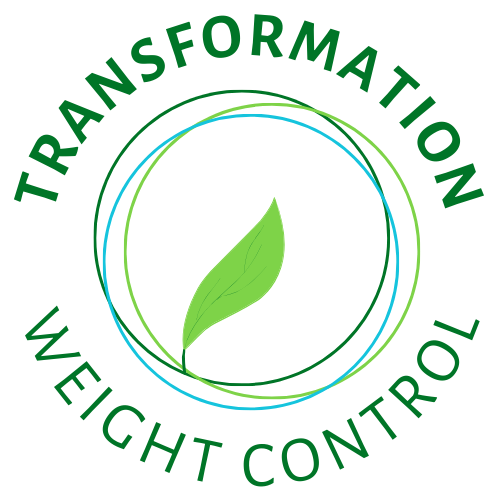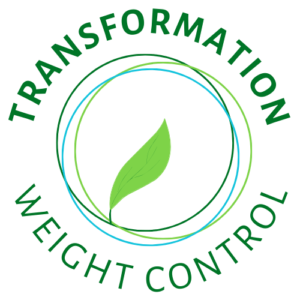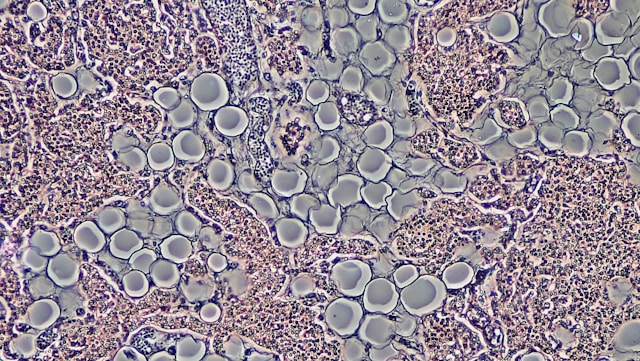By Rich Weil, M.Ed., CDE
Founder and Director
Transformation Weight Control
If you arrived at this blog by a link from the post on our Facebook page about “THE ‘E’ WORD”, then you can skip “Background” and go right to SECTION II. “The Benefits of Exercise”.
SECTION I. Background
I remember my first exercise group in a weight loss program way back in the 1980’s. I was charged with getting the participants to exercise. For weeks before the group, I labored for hours over walking programs, and other activities, with contingencies for everything in case you couldn’t complete my first suggestion. No Internet then, so I had to dig into it, which meant digging into textbooks but also going to a library for journal articles, and, I’m dating myself, but remember microfiche!!! Then, once I had my comprehensive list of benefits, I wrote them down on overhead transparencies (no PowerPoint at that time!). I figured that all I had to do was show the group members the benefits of exercise and they would do it. I passed out handouts of my exercise programs, and I remember as if it was yesterday, a woman standing up and saying, “I’m not doing any of this.” Honest to goodness!
What To Do?
Well, I was flabbergasted and I froze. I had no idea what to do, and frankly, I can’t remember what I did. But what I do remember is going home upset and thinking about what happened and what I was going to do about it since I had to return the following week. I came up with the idea that I would go in there and ask one, genuine, simple question, “Why don’t you want to do it?” I really couldn’t understand why anyone wouldn’t want to do it, that had never been my experience having always been on sports teams, so the question came right from my heart, and I was genuinely interested.
The Beginning
And no kidding, that started my career in effectively helping people exercise, lose weight, and keep it off. I remember reading two quotes, “You learn more by listening than talking”, and “I’ve got two ears and one mouth, so use your ears more!” Those resonated with me and certainly applied to inspiring people to become physically active people. Plus, it made my job more interesting, and more fun, and a robust learning experience. I would have to say that a lot of what I know about helping you transform yourself to a physically active person comes from my genuine interest in why this can be so hard, and from directly listening to what people had to say about their experiences. You don’t learn this stuff in textbooks.
Off I Went!
So, I went in that second week, asked them why they didn’t want to, listened to their exercise stories, their failures, and fears. They were braced for another annoying “rah-rah” presentation from me, but instead, I gave them a chance to speak about why they didn’t want to exercise, which disarmed them and made it easier for me to help them overcome the impediments, and help them successfully start easily at their own pace. I learned a lot in just one week, and off I went to a 44-year career of counseling people on losing weight, becoming a physically active person, exercising, and managing diabetes. And even after all these years, I still love it.
SECTION II. The Benefits of Exercise
Is there anyone out there who doesn’t know that exercise provides many health benefits? In fact, so many, that there’s not enough medication you could take to mimic all the benefits of exercise. But my experience is that showing people who are resistant to exercise all the benefits is not particularly effective in inspiring them.
Just One Exercise Benefits Slide and Resistance Exercise
With that in mind, I am going to show you just one slide with the benefits of exercise that I use all the time at TWC, not to inspire you (if it does, that’s great), but rather to inform you, and with one very relevant and positive caveat… all the benefits you read occur no matter what you weigh. I also plan to briefly discuss resistance exercise since it is finally an addition to the physical activity guidelines, plus, when you lose weight, you lose muscle and fat, and resistance exercise will help preserve it. Writing a blog on resistance exercise is on my list.
Physical Activity vs Exercise
There’s a difference. Physical activity is all the movement you do during the day, and exercise is more formal, exertional, continuous bouts that we call a “workout”. I like to start with increasing physical activity during the day for those who are resistant to formal exercise because it’s about changing habits, not training for a marathon. I also use the term “physical activity” in the beginning instead of exercise, because some people have a natural and understandably negative reaction to the word ‘exercise’. We can always increase later to exercise, especially after losing some weight, but at the beginning, I emphasize that it’s about intentional changes in your physical activity, however small you might think it is.
And I always ask how many people had a positive experience in gym as a kid. Only a few people ever say yes, and it’s always the case that they were good at it. Physical education in this country is unenlightened, and it turns kids off to physical activity so much so that by the time PE is no longer mandatory in school, those who are resistant steer clear. I mean, dodge ball is the worst for many kids, terrifying in fact, and getting picked last for a sport certainly doesn’t help with your exercise self-esteem. And then body shaming because of your weight, and shame because of your inability to excel at sports or other exercise or physical activities, shuts and locks the door on becoming physically active.
Sedentary Teens
By the time you have a sedentary teen, you can be certain they will become a sedentary adult. You can make the change to becoming a physically active adult, people at TWC do all the time (thus the word Transformation in the name of the program), it’s just more work than for others who were not intimidated or humiliated by it when they were younger.
My Approach, Part 1
So, my approach is to start by suggesting changes in physical activity in your life wherever you see the opportunity. Scan your universe and see where you can make any change in physical activity. Then when we set physical activity goals at the end of the first session, if someone says they are going to walk around the block on their way home before they walk inside, or take the stairs once that week instead of the escalator, or walk the extra block before getting on the bus, or park the car in the spot farthest from the mall and walk more, or take a walk at lunch to a park to eat instead of sitting at your desk, then I’m perfectly okay with that and supportive. You get the idea. Because again, it’s about making intentional changes in your physical activity, not training for a marathon. It’s the intentional, realistic changes that you succeed at that will build your physical activity self-efficacy and start you on the road to becoming a more physically active person. Self-efficacy is the belief that “I can” – a very good predictor of behavior change. In other words, if you ask someone if they can do something, and they say, “yes I can”, then chances are good they will do it.
Plus, you lose hardly any weight at all with physical activity or exercise, so why overwhelm you with yet another behavior change that won’t help you lose weight when we’re already asking you to work on new food plans, and implementing new behavior strategies that the psychologist teaches? For these reasons, we don’t start the formal part of the physical activity intervention at TWC until the eighth to tenth week of a group.
Two Unhelpful Role Models!
- “Whenever the urge to exercise comes over me, I lie down until it passes away”. Mark Twain, although attributed to others as well.
- “The Good Lord gave us a finite number of heartbeats and I‘ll be damned if I’m going to use up mine running up and down a street.” Neil Armstrong, U.S. astronaut.
My Approach, Part 2
To approach physical activity in the least intimidating way, and to help improve what I call ‘inactivity catharsis’, I start with two simple questions that everyone who has ever been scarred by physical activity has lots to say. I ask, 1) “What are your impediments to physical activity and 2) what’s so comfortable about being sedentary (inactive)?” I announce that this is your opportunity to bitch all you like about physical activity and get a load off your chest, a load, and most likely a secret, that you’ve probably been carrying around with you since your early days in PE.
These are the most common responses. And once we list them, we have a long discussion about all of them to start to get it out of your system, gain some insight and perspective, and make the entire experience less threatening.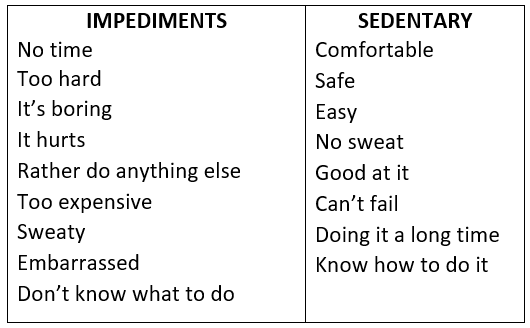
Once we’ve processed the impediments, and comfort and familiarity of being sedentary, we move on to some basic exercise physiology. My blog, “Does it take 20 minutes to burn fat during exercise?” is worth a read. Burning fat is one of the most important topics I cover in the beginning, because, after all, who doesn’t want to burn fat?
Once I’m done with that, I ask everyone to set a physical activity plan for the week, review everyone’s plan, and then check in the following week.
R.A.P.S. for Goal Setting
I suggest using the acronym R.A.P.S. when setting weekly physical activity goals. That means, Realistic, Achievable, Practical, and Specific. If someone commits to walking one day a week (Realistic and Achievable) for 15 minutes (Specific) right before dinner (Specific and Practical), then that’s R.A.P.S., and I support it. Note that the walking is set for before dinner. I call that a context goal (linked to an event), and not set a specific time of day, because some people don’t like setting a time of day; it feels too restrictive, so context is fine (e.g., after breakfast, right before lunch, as soon as I get home from work).
The Foundation
The foundation of you becoming a physically active person if you have been resistant, or emotionally scarred by physical activity at a younger age (what I frequently call PAPTSD – Physical Activity Post-Traumatic Stress Disorder), is to start with goals you can achieve. When you succeed, you build your self-efficacy (the belief that “I Can”, is probably the best predictor of behavior change), and then momentum will follow as you continue to succeed at your realistic goals and feel rewarded by it. I do not believe that momentum comes first by just washing over you one morning when you wake up. Instead, it takes planning, and then when you achieve your plan, the momentum naturally follows close behind, and when this model continues, momentum becomes more permanent. In other words, more habitual (be sure to read my blog, “Building Healthy and Positive Habits”) and then automatic.
Rewards
I believe the act of following through and succeeding can be enough of a reward to make this approach work. Like I said, above, self-efficacy is one of the best, if not the best, predictor of behavior change, and I don’t think you have to reward yourself with a massage, watching a movie, getting your nails done, or some other tangible reward when you build self-efficacy. If you like the idea of those tangible rewards, then go for it! I think, though, that the closer to the activity your reward is, the more effective it is at building self-efficacy and momentum. If you think about it, your massage may be a day or two after your workout. That decreases the effect of the reward because you have to wait, while achieving your goal is immediate and can be enough reward all by itself. In fact, keeping records on a hard copy calendar and put some type of sticker (e.g., flowers, or whatever sticker you like – there are dozens), gold star, or check off the days that you fulfill your goals, is immediate, and can be plenty of reward and probably all that you need to build self-efficacy and mastery over this behavior change. I know, because I’ve seen it work a zillion times at TWC. With their permission, here are some examples for keeping track of exercise from two very successful participants in our program.
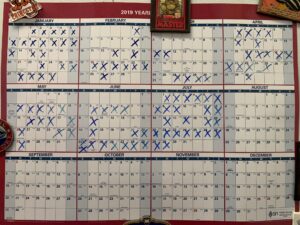
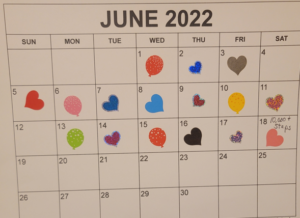
The Greatest Walking Plan of All Time
One suggestion I make to help set realistic goals is to introduce the greatest walking plan of all time, 5-minutes out, 5-minutes back! You start by walking away from your home, or wherever you are, for 5 minutes, then at 5 minutes turn around and walk back. That’s it! Ten minutes. And you’ve achieved your goal.
For All You Perfectionistic Thinkers!
If you have a problem with starting realistically to build self-efficacy, such as the plan I just mentioned, and you tell yourself it’s not enough, then you’ll probably deplete your efforts. If this describes you, be sure to read my blog, “Breaking Free from Maladaptive Perfectionism: A Key to Weight Transformation”, and while you’re at it, check out “Self-Acceptance – A Journey of Compassion and Growth” and “Cultivating Self-Compassion: A Strong Predictor of Weight Loss and Preventing Regain”. You’ve got your work cut out for you!
The Second Week
Once folks come back to the second group the following week, we review how they did with their goals, set new goals, I teach some more exercise physiology, then I demonstrate a simple resistance exercise, the wall press. I do that because 1) there’s always a wall somewhere, 2) it takes 30 seconds, and 3) because when you lose weight, you lose muscle and fat, so getting an easy-as-can-be jump start on resistance exercise will serve you well. One set of 12 repetitions is plenty to get started. And you can start with one of the four presses below, selecting the one you can do 12 times with exhaustion at the 12th rep with good form, with a straight back (tighten your abs to help), just like in the pictures. The idea is to progressively make them harder (#1 easiest to #4 hardest) so that you can continue to increase your strength. Note: You can do #3 with your knees on the floor but lean against a bed or sofa instead of the floor.
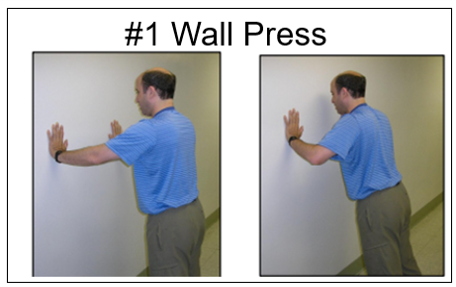
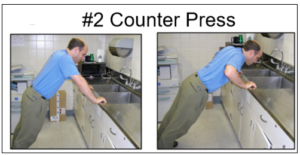

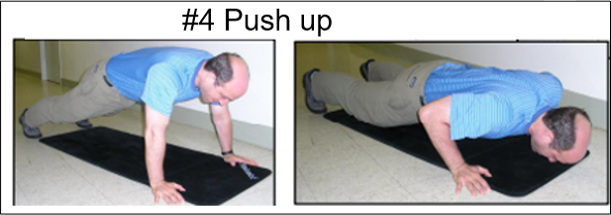
Here’s What Happens to Muscles When You Perform Resistance Exercise – All a Good Thing!
- You break down muscle tissue.
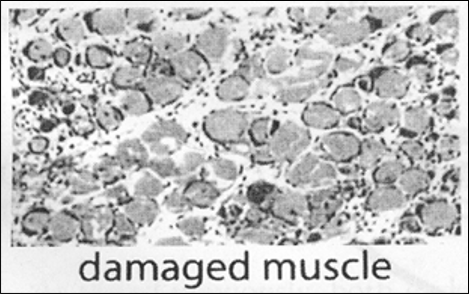
- A stem cell, which plays a crucial role in the growth, repair, and regeneration of tissues in the body, is stimulated and can develop into a variety of specialized cells, and can also divide and produce identical copies of itself.
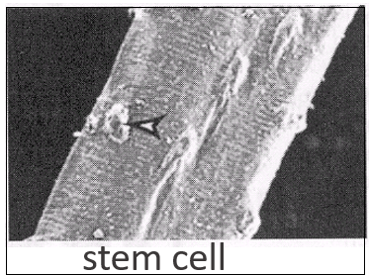
- Once the muscle is fully healed, you have regenerated muscle fibers.
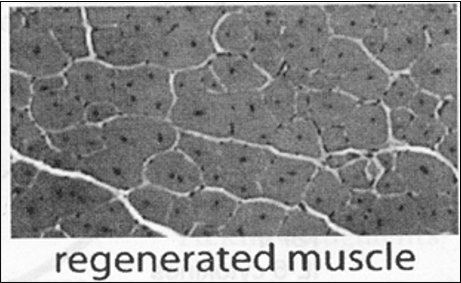 Source: Hawke TJ. Exercise Sport Science Review April 2005
Source: Hawke TJ. Exercise Sport Science Review April 2005
Metabolic Rate and Muscle
And in case you didn’t know, the more muscle you have, the higher your metabolic rate will be, as shown in the graph below. Who doesn’t want a higher metabolic rate! And as I mentioned already, writing a blog about resistance exercise in on my list, so more information to come!
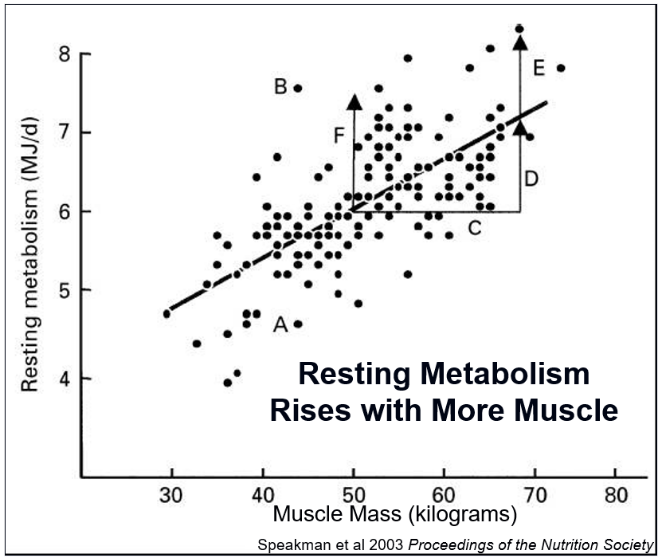
Physical Activity Guidelines for American Adults
Once everyone in the group is starting to feel more exercise self-efficacy (“I Can”), and the physical activity plans are becoming more of a habit (by setting realistic goals, repeating, and succeeding), we move on to the physical activity guidelines. As you can see, there have been ten versions. The three I’m focusing on in this blog are #1, #3, and #4. I have included pictures of the 2007 research article which led to the 2008 guidelines, and the 2018 version. Following that is a summary of all the guidelines.
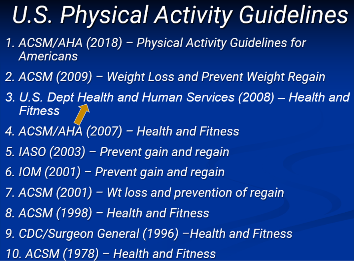
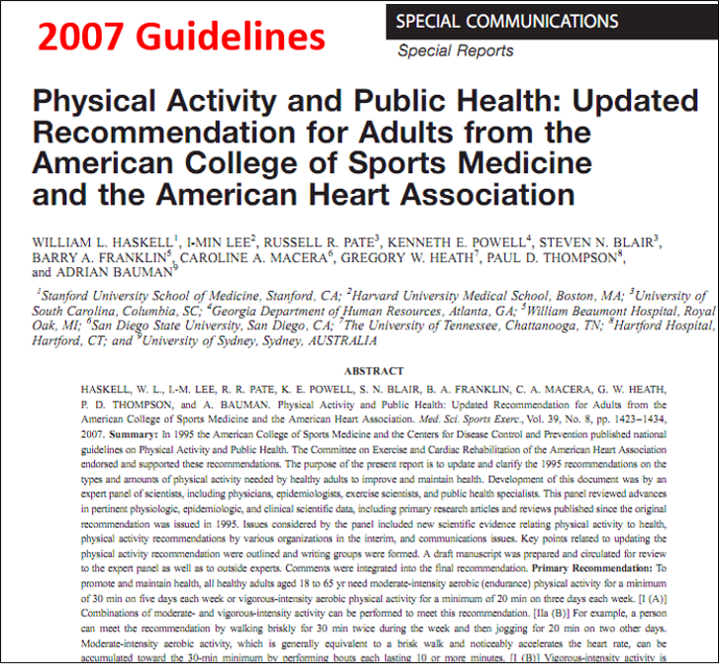 Source: https://www.ahajournals.org/doi/pdf/10.1161/circulationaha.107.185649
Source: https://www.ahajournals.org/doi/pdf/10.1161/circulationaha.107.185649
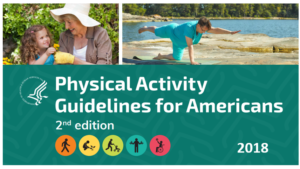 Source: https://odphp.health.gov/sites/default/files/2019-09/Physical_Activity_Guidelines_2nd_edition.pdf
Source: https://odphp.health.gov/sites/default/files/2019-09/Physical_Activity_Guidelines_2nd_edition.pdf
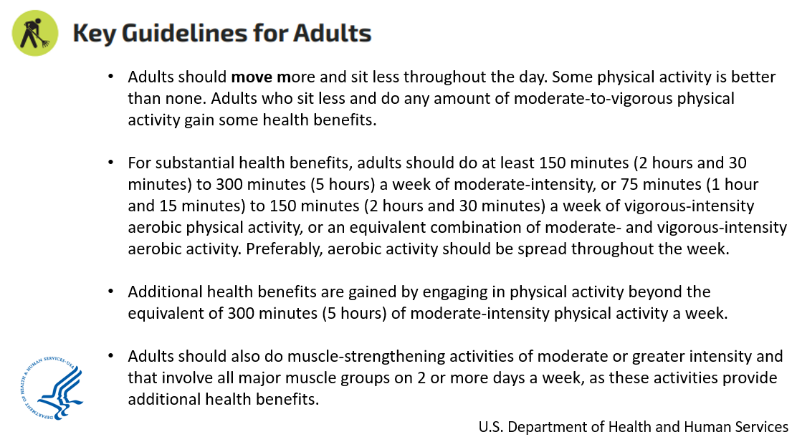 Source: https://odphp.health.gov/sites/default/files/2019-09/Physical_Activity_Guidelines_2nd_edition.pdf (page 8)
Source: https://odphp.health.gov/sites/default/files/2019-09/Physical_Activity_Guidelines_2nd_edition.pdf (page 8)
Exercise Benefits No Matter What You Weigh!
You can expect the following benefits from adhering to the physical activity guidelines. It’s important to know that exercise will provide all of these benefits without regard to your body weight. In other words, it doesn’t matter what you weigh, you can still become fit and healthy.
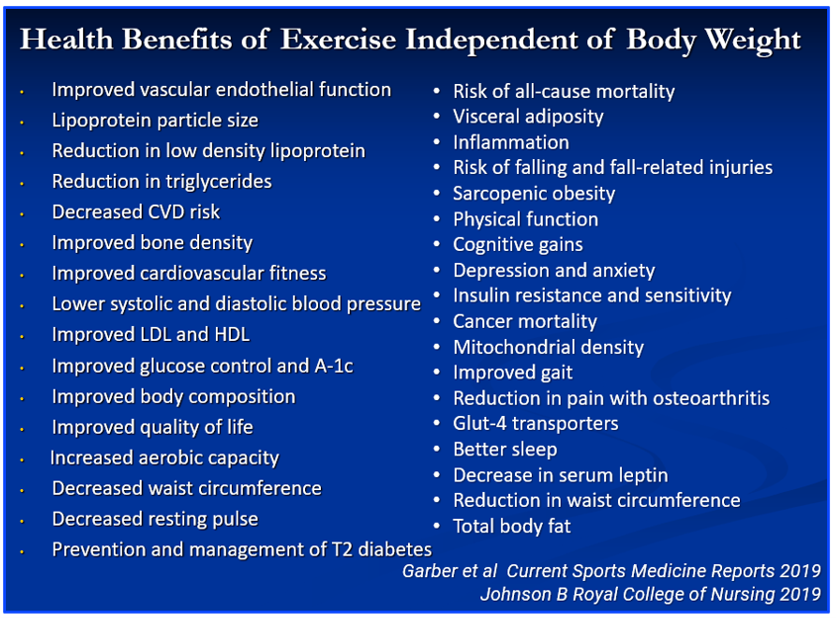
***Of noteworthy Importance! Most people in the field consider exercise to be the single most important lifestyle behavior for keeping your weight off once you lose it! I certainly agree with that.
Uh Oh! What Percent of American Adults Follow the Guidelines?
As good as physical activity and exercise is for you, almost 50% (46.3%) of American adults do not meet any of the aerobic or muscle strengthening activity guidelines.
This graph from 2020 shows the percent of American adults who adhere to physical activity guidelines:
- 8% adhere to muscle-strengthening guidelines
- 2% adhere to both aerobic and muscle-strengthening activities
- 7% adhere to aerobic only, and
- 46.3% did not adhere to both aerobic and muscle-strengthening activities
 https://www.cdc.gov/nchs/data/databriefs/db443.pdf
https://www.cdc.gov/nchs/data/databriefs/db443.pdf
Ok, So Now What?
- Set your plan for the week. Think R.A.P.S. Write it down. Think carefully about the type of activity, day(s) of the week, minutes of activity, and time of day or context (e.g., after dinner). Think about what you are willing and capable of doing, a plan that fits in your life. Treat it like an appointment if necessary.
- I recommend keeping a record. Use a calendar, your phone, or any other way to keep track. As I already mentioned, some folks in our program have a hard copy calendar and put a sticker or gold star every time they follow through. It’s visual and is its own reward, which will help build your self-efficacy. Don’t forget these record keepers!


- Plan for contingencies. Have a look at my blog, “Building Healthy and Positive Habits”. You’ll learn planning skills such as “if-then” for behavior change.
- Be flexible. If at first your plan doesn’t work, evaluate it carefully and determine where problems might have come up. For example, if you said you were going to ride your stationary bike after dinner, but you know you frequently get home from work late, and then eat, and then you’re too tired to exercise, you can always troubleshoot and modify.
- Experiment until you work it out, until physical activity and exercise become more habitual. The hard work will be worth the effort!
GOOD LUCK!
© Richard Weil, M.Ed. CDE, 2024, All Rights Reserved
